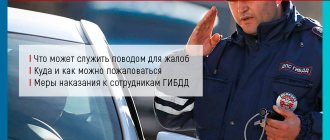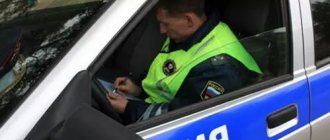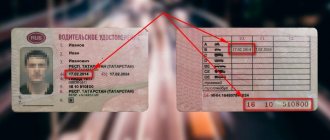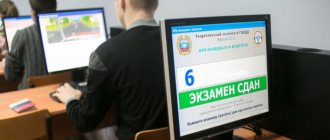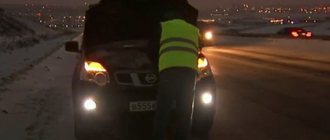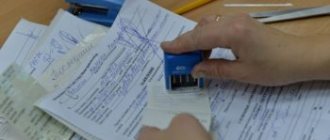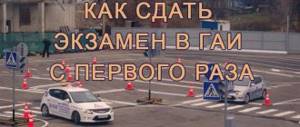Order 186 of the State Traffic Safety Inspectorate “On measures to improve the activities of the road patrol service for safe traffic of the Ministry of Internal Affairs of Russia” was issued in 2009 with the aim of improving the activities of traffic police officers and improving the quality of their work.
Dear readers! Our articles talk about typical ways to resolve legal issues, but each case is unique. If you want to find out how to solve your particular problem, please use the online consultant form on the right or call. It's fast and free!
The main responsibilities (according to the order) include ensuring accident-free movement of vehicles, creating favorable conditions for compliance with traffic rules by all participants and motorists on the roads.
What are the administrative regulations of the traffic police?
The regulation of January 2, 2009 states that traffic police officers must strictly perform their functions, keep the entire situation on the roads under strict control, and conduct explanatory conversations with citizens.
According to the administrative regulations (clause 63, order 186), stopping a car is permissible for employees in the following cases:
- visual recording of signs of violations by the driver;
- non-compliance with safety rules according to indicative data or information received from the duty station;
- receipt of data from passengers or the driver indicating an incident, crime, offense;
- attracting a motorist to provide assistance, if necessary, to other road users;
- collecting data, obtaining indicative information on the search for a particular type of transport that is allegedly wanted.
Only if there are compelling reasons, employees have the right to stop the car. Cargo, documents, and passports of motorists (passengers) are checked at traffic police posts and only in designated areas.
Main points of the document
185 order of the traffic police contains all the information regarding the prohibitions and permissions of all representatives of the traffic police and the traffic police. Administrative regulations contain all the information that reflects the responsibilities and tasks of employees. The document has quite a few pages. It has about 22 pages, which reflect specific information.
The most important points in the document are:
- who has the right to control street traffic;
- how to correctly identify road users;
- correct and correct attitude of representatives towards participants;
- powers of traffic police representatives;
- appearance of representatives of traffic police officers at posts;
- the possibility of using special equipment by a traffic police representative;
- all reasons for stopping are regulated in accordance with the legal act presented above;
- all the reasons why you can ask a motorist to get out of the vehicle;
- conditions for the possibility of inspecting a vehicle, including checking license plates;
- conditions for writing a document - a resolution on an offense or a receipt for payment of a fine;
- procedure for conducting a blood alcohol test.
The legal act contains a lot of information for motorists that will help protect their rights if necessary.
Functions of the road patrol service
Lawyers advise you to familiarize yourself with all the important aspects of Order 186. Drivers have many questions regarding unlawful actions of traffic cops.
In addition, motorists can always actually exercise their rights in practice, prove their innocence and unlawful actions on the part of traffic police officers.
Patrol inspectors must strictly follow the laws. Any deviations from the standards are unacceptable.
Direct functions are considered:
- suppression of various offenses;
- respectful attitude towards pedestrians and other traffic participants;
- creating normal conditions on the roads for all participants;
- monitoring traffic participants, monitoring compliance with all rules and regulations on the road in order to ensure traffic safety;
- carrying out urgent actions directly in the event of an accident;
- transport support if necessary;
- emergency stop analysis;
- conducting explanatory conversations to reduce the number of road accidents;
- suppression, timely informing people about emergency situations on the roads;
- taking urgent measures of various kinds to ensure road safety.
Wording 185 of the traffic police order
In order to improve the state body in the field of control over road users, the Administrative Regulations of the Min. were approved and put into effect on September 1, 2009. Internal Affairs of the Russian Federation.
For this purpose, a decision was made to organize the study and implementation of the requirements of the Administrative Regulations by representatives of the state body. Next, it is necessary to take measures to produce strict reporting forms for statistics. It is also worth equipping the combat unit with traffic police.
It is also necessary to conduct additional special programs. professional retraining and advanced training in accordance with current legal acts.
How should traffic police officers behave?
Motorists should understand that it is not always acceptable for employees to stop their car for no reason.
Lawyers warn that a delay is possible only if there are compelling reasons. To check documents or cargo, you can stop the car directly at a stationary traffic police post and in no other place.
It is strictly prohibited to stop a vehicle in unspecified places without a reason. A forced stop is possible only in certain cases, immediately upon the onset of a real threat of danger, when the patrol car must turn on the light signal.
The traffic inspector, in turn:
- wear regular clothes;
- immediately approach the driver when stopping the vehicle;
- behave tactfully with drivers;
- address you exclusively as “you”;
- be explained in a clear and accessible form;
- provide your official ID in a detailed format;
- carefully explain the reason for stopping without moralizing and only relying on the laws;
- provide information and telephone numbers for appeal if the driver has any complaints;
- at the request of motorists, tell how to get to the place of residence of the official on duty;
- do not prohibit the use of equipment (today this is permitted by law);
- handle the provided documents carefully and do not make any notes.
The traffic police inspector must return money or securities, documents, as drivers often do, in order not to pay fines. It is strictly forbidden to take any material valuables from drivers!
Behavior of a traffic police officer
185 of the traffic police order also regulates the behavior of a government agency employee.
Control the behavior of the modget:
- local traffic police department or district;
- federal authority of the State Traffic Safety Inspectorate;
- police representative at the special facility.
All representatives are required to:
- dress appropriately;
- there must be a number badge on the chest;
- For identification, you must have a service ID.
In accordance with Order 185 of the State Traffic Safety Inspectorate, all representatives undertake to address the driver only as “you” and only after presenting their identification. Representatives must politely explain the reason for the stop.
Thanks to Order 185 of the traffic police, not only a representative of a government agency, but also a car owner can use a voice recorder or video recorder. The representative must handle all documentation carefully. If funds are found, return the documents and ask them to return them without them.
The legal document also provides for the possibility of using force, but only in difficult situations. Also, the representative has the right to stop illegal actions if there is a threat to the lives of other citizens.
Stopping a car
If the car is delayed, the owner may not rush to leave his place. The inspector must come up in person, introduce himself, and clearly state the reasons for stopping the car.
Attention motorists! If an inspector stops a car to check documents, but there is no stationary post nearby, then lawyers advise referring to this order (number 186). A traffic police officer can say that administrative regulations are an official document and have no relation to outsiders.
According to the Constitution (Article 229, paragraph 4), any citizen and motorist can use any information from the regulations if necessary, without excluding a departmental order.
Attention! Checking the driver’s documents, also for the cargo being transported, should be carried out directly at the permanent post. Outside the post, inspectors can stop the car during special operations and in emergency cases. It looks like riot police in bulletproof vests arranged around them.
Of course, it is possible to stop the car directly when trying to drive into a closed area or when visual violations are detected on the part of the driver. The reason for the delay may be theft, the need to conduct interviews as eyewitnesses of the crime.
When a vehicle is delayed, an employee can use a loud-speaking device, a gesture with a reflector, or a whistle to attract attention.
Drivers! Contact our professionals for help so as not to fall into the trap of dishonest traffic police officers.
Reasons for stopping the vehicle
It is important for drivers to know the main reasons why traffic police can stop a car. In other cases, you can safely refer to order 185 of the traffic police, thus stopping any unlawful actions of law enforcement officers.
Stopping the vehicle is permissible when:
- obvious signs of traffic violations by the driver;
- speeding, as recorded by instruments and radars;
- traveling without fastened seat belts;
- failure to comply with safety and maneuvering conditions;
- violation of parking rules;
- the need to conduct a survey of persons in the vehicle regarding the circumstances of the case during an accident;
- the need to involve persons in the car as witnesses, to provide assistance from the driver in urgently transporting a victim in an accident to the hospital in the event of an accident on the road.
Traffic police inspectors are required to inform drivers of the purpose of using the car and indicate the shortest route of travel. In case of refusal to comply with such requirements, the driver may be removed from control if necessary.
Although the motorist has the right, in turn, to demand compensation under the law for expenses incurred or harm caused as a result of the actions of the traffic police inspector. At the same time, the inspector does not have the right to refuse to provide the driver with a certificate or entry on the waybill upon personal request.
In other cases, stopping is permissible directly at stationary posts.
When do traffic police officers have no right to stop a car?
The reason for the delay must be reported by the inspector, and only if there are grounds, if there is no stationary post nearby
Lawyers recommend asking traffic police inspectors for an explanation of the reason for the stop or for presenting grounds in the case of drawing up a protocol, which, by the way, is subject to appeal within 10 days.
Sometimes traffic cops themselves provoke an unpleasant conversation by communicating with drivers in a raised voice.
A note for us! Do not engage in polemics that are useless and pointless. If you disagree with the facts of traffic violations, remain confident and calm.
Employees should not stop a car while remaining in their car or in one that is not equipped with signs or flashing lights.
Reasons for stopping
In accordance with Order 185 of the State Traffic Safety Inspectorate, a representative of a government agency has the right to stop almost any vehicle.
The basis here could be:
- violation of traffic rules by technical means;
- presence of data on theft or other illegal actions;
- availability of information about the participation of a vehicle in an accident;
- there is a need to interview a traffic participant in the event of evidence of an accident;
- performing adjustments;
- engaging the driver as a witness;
- special event to check the vehicle;
- other actions aimed at providing assistance to traffic police representatives.
A selection for you!
Download forms and sample documents for motorists to a safe place.
What rights do traffic police officers have?
Inspectors may, in accordance with the current procedures:
- change patrol deployment;
- subsequently report to management about changes on the road and record the facts in an audit trail;
- draw up protocols and make decisions within their competence;
- provide instructions;
- remove the driver from driving the vehicle in case of alcohol intoxication;
- stop when signs of traffic violations are detected.
The delay for the purpose of checking the technical condition cannot exceed more than 20 minutes. Although it is worth understanding that the time required to eliminate violations and prepare documents is not taken into account.
Summary of the main points of the administrative regulations
The administrative regulations of the State Traffic Safety Inspectorate (Order 185 of the Ministry of Internal Affairs of the Russian Federation) contain five sections and 18 applications that every traffic police officer must know . Drivers do not need to know all the features of this regulation, however, the document indicates important provisions that can help them in controversial and conflict situations with traffic police representatives. So, let's look at the most important of them:
- If a traffic police officer communicates with other persons by telephone, you must introduce yourself , indicate your affiliation with the traffic police, and only after that answer the caller’s questions within the framework of your own authority. This procedure describes the procedure for communicating traffic police officers with citizens by telephone and consulting them if they have questions. In addition, this Law on Police (185 Order of the State Traffic Safety Inspectorate) establishes requirements for the design of websites, as well as the location of contact information and information about the consultation procedure.
- Many drivers have often encountered incorrect and inappropriate communication methods of traffic police officers. This deficiency is eliminated in the regulations and establishes clear rules for how a traffic police officer should introduce himself and communicate with road users. The inspector must address himself as “you” , be self-possessed and calm, and present his own requirements tactfully, convincingly, objectively and clearly. If the driver is very nervous, the traffic police officer must provide as much time as the driver needs to calm down and continue the conversation. However, drivers themselves must understand that failure to comply with the legal requirements of the inspector may lead to administrative penalties. Therefore, in this case, the rights of both drivers and traffic police officers are preserved. More detailed information is contained in paragraph 20 of the administrative regulations in question.
- Both the driver and the traffic police inspectors have the right to use sound and video recording equipment (with the exception of cases expressly provided for by law.
- An administrative procedure, in accordance with Order 185, is any legal action of a traffic police employee through which they fulfill the obligations legally imposed on them. In particular, this provision establishes the obligation to wear the uniform and badge of the traffic police of the Ministry of Internal Affairs while on duty.
- The direct responsibility of inspectors is to control traffic in a certain area. And to fulfill this duty, traffic police authorities are allowed to use special means of recording and control using video and photography from places that are inaccessible to the driver’s visibility (behind turns, road signs, terrain, etc.). The traffic police vehicle must have special means capable of automatically recording. Please note that if traffic police officers travel in vehicles that are not equipped with color schemes, drawing up reports of an administrative offense is not allowed.
- Let us note that the regulations prohibit stopping road users in places where stopping is not allowed , however, exceptions are possible in cases where such a stop is due to objective reasons.
- The driver may leave the vehicle only in cases of obvious signs of alcohol, toxic or drug intoxication, if it is necessary to carry out a search and personal inspection, as well as if it is necessary to eliminate technical malfunctions of the vehicle.
Stopping a car
Very often, inspectors abuse their powers and stop vehicles for no reason. In Order 185 of the State Traffic Safety Inspectorate, the reasons for the stop are strictly regulated and defined by the legislator. Please note that a vehicle can be stopped on the following grounds:
- Technical means installed on a vehicle that create a danger to traffic;
- Availability of information about the driver’s involvement in an accident or crime. Information can be obtained from reports of witnesses, received orientation, other traffic police squads, etc.;
- Availability of information that the vehicle is stolen, wanted, or may be used for illegal purposes;
- The need to interview the driver of the vehicle and his passengers as eyewitnesses of a crime or accident;
- The need to use the driver as a witness;
- The need to use a vehicle (within strictly established limits of the law);
- Providing assistance to other drivers and road users;
- Carrying out special events aimed at identifying drivers and transported goods, which are regulated by departmental administrative acts;
- Checking documents (both driver and passengers), checking the availability of documents for the vehicle and the right to use the car.
In 185 Order of the Traffic Police, paragraph 63 (above) is only a listing of the grounds for stopping the car. Let us note that in order to fully familiarize yourself with the main points of this procedural action, you must read paragraphs. 63-67 of this Order.
How should the inspection be carried out?
Inspection of the vehicle and the cargo in it is carried out in accordance with the requirements of Section III of the administrative regulations (clauses 149-154). In accordance with clause 149, an inspection can only be carried out on the following grounds:
- Availability of information about the use of the vehicle for illegal purposes;
- Checking the vehicle markings with the data indicated in the documentation;
- Transportation of cargo that should not be transported in accordance with the transportation documentation;
Based on the results of the inspection, the traffic police inspector is obliged to draw up an appropriate report , which indicates all the significant details of the inspection, as well as information about the driver, the inspector, etc. After inspection and if there are no signs of violations, the traffic police officer gives permission for the vehicle to continue moving.
Necessary grounds for inspection of the vehicle and cargo
Traffic police officers can inspect vehicles and cargo, but if there are grounds:
- visual (according to the received data) discrepancy between the documents for the transported cargo;
- permission to transport any dangerous goods (explosives, machine guns, drugs).
During the inspection, a report must be drawn up, and two clear witnesses are taken as witnesses. It is allowed to use videos and photos when inspecting a vehicle.
Note to car enthusiasts! It is important to understand the essence of the inspection as a visual examination of the vehicle and cargo. As a rule, no protocol is drawn up. But the employee may require documents to verify the entries in the registration documents with the markings on the vehicle. The driver may not get out of his car at the time of inspection, although passengers will still have to get out if necessary.
It is important to understand the meaning and interpretation of Order 186 of the traffic police. Traffic police inspectors must respond adequately to emergencies on the roads, but not neglect their powers. All actions must be carried out exclusively within the framework of the law or regulations, and for inspectors, compliance with all standards is imperative.
Motorists! Know your rights and responsibilities. If you don’t know what to do in a difficult situation or think that traffic police inspectors committed violations, contact our lawyers. We will help you understand the most confusing and ambiguous situations on the roads.
Didn't find the answer to your question? Find out how to solve exactly your problem - call right now: +7 (Moscow) +7 (812) 309-53-42 (St. Petersburg) It's fast and free!
Free online consultation with a car lawyer
Didn't find the answer to your question? Find out how to solve exactly your problem - call right now: +7 (Moscow) +7 (812) 309-53-42 (St. Petersburg) It's fast and free!
Reasons for car inspection
The grounds for inspection of a vehicle are:
- the transported cargo does not comply with the documentation;
- if necessary, verify vehicle markings;
- checking the vehicle for the presence of items with which the offense was committed;
- checking the presence of narcotic and explosive ammunition;
- detention of citizens who are in a vehicle.
What should be indicated in the act
In this case, the civil service inspector is obliged to draw up an inspection report of the vehicle and cargo. The document must indicate the date of preparation, information about the position of the employee, information about the witnesses present at the time of the inspection.
Next comes information about the vehicle and cargo. It is best to enter data on recording evidence if available. After the description, fixation materials are attached to the document.
